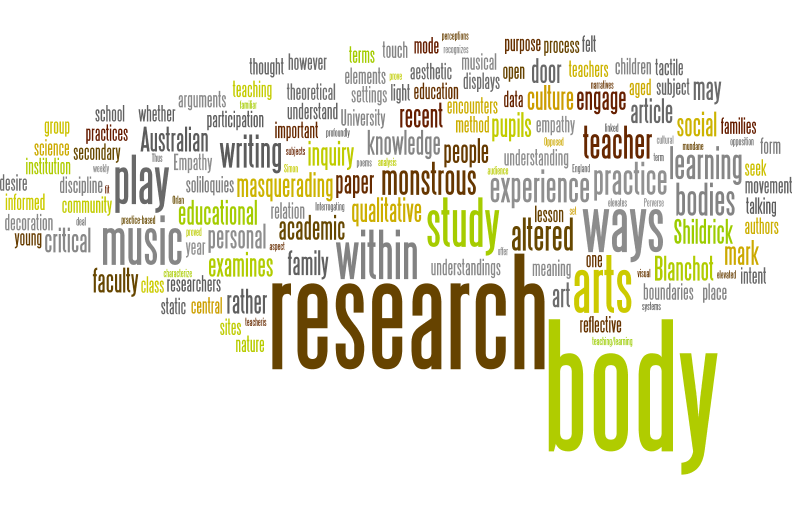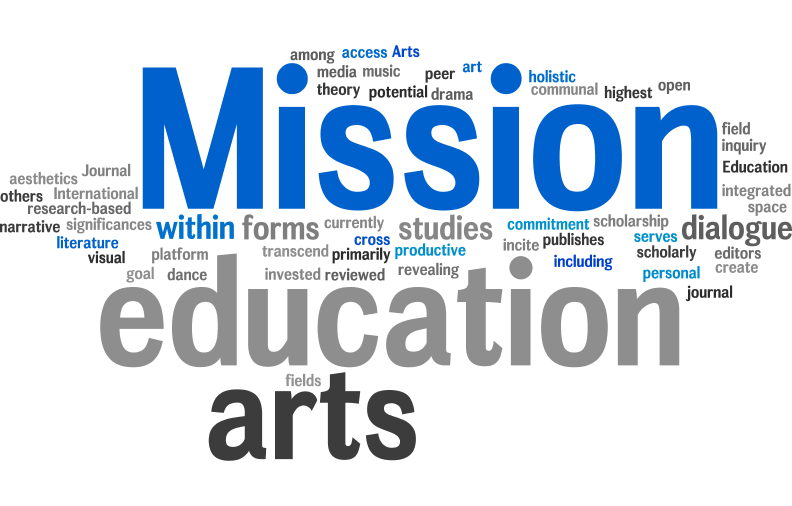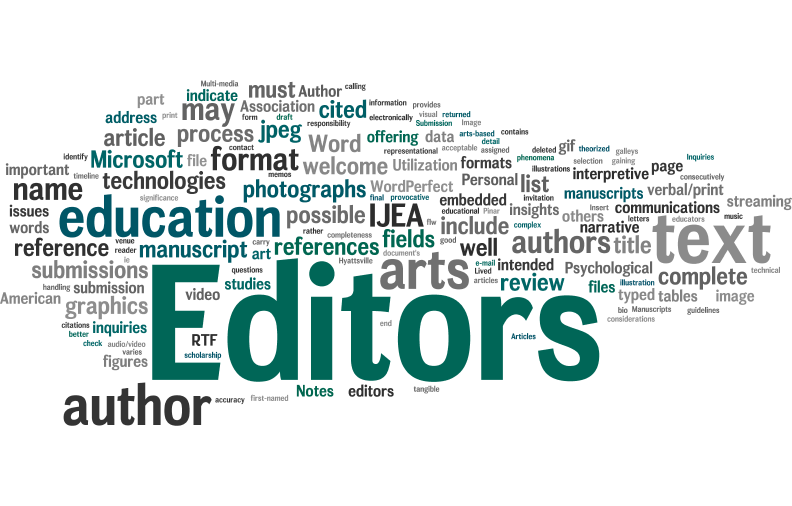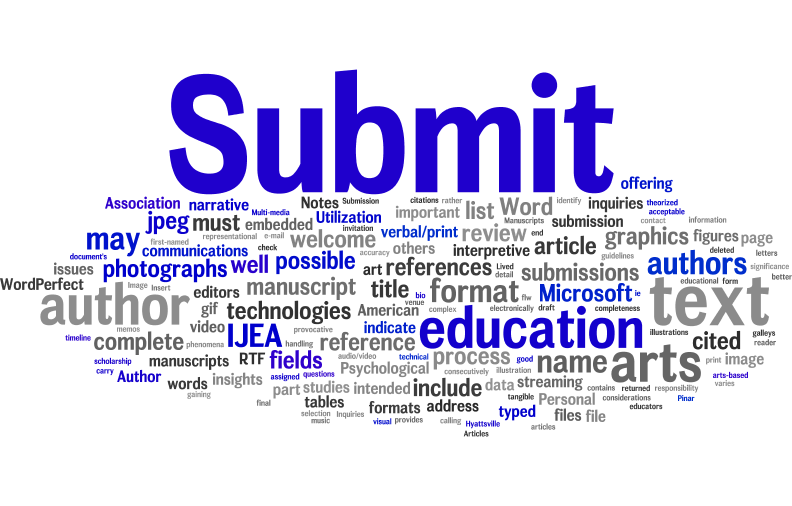2003 Volume 4
Articles and Abstracts

Articles
Volume 4 Number 1: Monica Prendergast: "I, Me, Mine: Soliloquizing as Reflective Practice"
Arts-based qualitative researchers are expanding the borders of what constitutes educational research through work that recognizes and elevates the creative/imaginative elements at play, within a social science frame, in the researcher's interaction with his or her subject of inquiry. This paper examines the construction/creation of soliloquies as forms of reflective practice through an understanding of this dramatic voice applied to qualitative research writing. A recent research study in theatre audience education at the University of Victoria, British Columbia, Canada, presented soliloquies expressed as personal and data poems, dialogues of symbolic interactions (between "I" in practice and "Me" in reflection), as autobiography (talking to myself about myself), and autoethnography (talking to the group within which I place myself). Soliloquy writing offers myriad ways to engage in reflective practice and qualitative interpretive inquiry.
Volume 4 Number 2: Gary Peters "The Aestheticization of Research in the Thought of Maurice Blanchot"
Increasingly familiar within the State University system, the thought of Maurice Blanchot is in danger of settling all-too-comfortably into a research culture that in fundamental ways is radically at odds with the peculiar trajectory of his singular writing. In the light of this, the current essay is intent on returning Blanchot to the “outside,” to an “exteriority” that is not critical of the hegemonic research culture, but Other—an Other mode of research. Trying to think of research affirmatively, in the absence of the negative dialectics more typical of the academic communicative community, both throws new light on Blanchot’s own aesthetic method while, importantly, offering a great deal to those intent on imagining models that better “fit” the experience of art practitioners engaged, whether formally or informally, in practice-based research. Driven by the interminable waywardness of “fascination” rather than the teleologies of knowledge and understanding, Blanchot proposes (albeit fleetingly) a non-methodological method of progressing that speaks from the experience of the artist and an aesthetic that is not only unengaged with the will-to-knowledge but, in fact renders such knowledge “truly impracticable.” Perverse as this may sound, the very thought of such an Other mode of research may yet prove to mark an important and necessary shift in what “counts” as research within an academic culture that must increasingly familiarize itself with the alterity of art…and then take it seriously (as research).
Volume 4 Number 3: Margaret Macintyre Latta & Karl D. Hostetler "The Call to Play"
This article explores the nature of play and its presence and potential in teaching and learning encounters. Play is portrayed as a movement that can characterize the process of learning and teachers’ reflections on their practice. The exercise of techne and phronesis are found to be key but problematic elements in this movement. The paper is in the form of a conversation, a medium calling the authors themselves to play with the play that might occur in classrooms. Thus, the authors’ play is itself a subject for inquiry. Their interplay warrants considering play to be an elemental activity for reconceptualizing teaching/learning practices.
Volume 4 Number 4: Margaret S. Barrett & Heather Smigiel "Awakening the 'Sleeping Giant'?: The arts in the lives of Australian families"
In 2001 a nation wide study (Costantoura, 2001) raised a number of questions in relation to the arts and Australian families. This study used group interviews and surveys to question people aged between 18 and 60 about their participation in the arts. Results from this study suggested that the arts add an important dimension to family life; however, the ways this occurs and the nature of family participation in the arts were not made clear. Significantly, this study did not include the perceptions of young people under the age of 18. Here we report on one aspect of a complementary research project that sought to provide more information concerning the ways in which Australian families participate in the arts and to identify the meaning, purpose, and value of the arts for children (ages five to fifteen) in Australian school and community settings. Specifically, we focus on the ways in which children describe their engagement with the arts in family settings using the voices of young people as the primary source of data.
Volume 4 Number 5: Stephanie Springgay "Cloth as Intercorporeality: Touch, Fantasy, and Performance and the Construction of Body Knowledge"
The monstrous body (Shildrick, 2002), the altered body (Featherstone, 2000) and the masquerade (Tseëlon, 2001) have been subjects of recent theoretical analysis through scholarly writing and the works of contemporary visual artists (Wilson, Dyck, Orlan). Each term while slightly different, marks a theoretical concern with bodies that are conditioned as the abnormal other. Theories that engage with the monstrous, altered, and masquerading body do not position these terms as static binaries in opposition to the ideal or normal body, but rather their arguments are located within the body itself such that encounters with the strange are constant conditions of becoming (Shildrick, 2002). The latent body is always in process, open, pliable, and protruding. Opposed to the classical body, which is monumental, static, and standard, the monstrous, altered, and masquerading bodies resist, exaggerate, and destabilize distinctions and boundaries that mark and maintain bodies, signifying pleasure and desire as sites of insurgency. Bodies have been accorded a place of central importance in recent scholarship as researchers attempt to construct the meanings of the lived body, the social body, and body image (Grosz, 1994). Each discipline whether science, technology, sociology, sport, and/or art has de-constructed and challenged western philosophy which is rooted in a mind/body split (Price & Shildrick, 1999). What is evidently missing from this cogent literature is a re-representation of the body as tactile and felt. In this paper I analyze the monstrous, altered, and masquerading body not to further dichotomous thinking and systems of regulation and control, but as sites of excess where the pleasures of the body are central aspects of body knowledge. Interrogating the boundaries of the body, I offer a model of intercorporeality (Weiss, 1999) that examines the body in relation to other bodies and the ways in which knowing and being are informed through generative understandings of touch, fantasy, and performance. The arguments call for educational practices that are open to desire, allowing for tactile and felt knowledges.
Volume 4 Number 6: John Finney "From Resentment to Enchantment: What a Class of Thirteen Year Olds and Their Music Teacher Tell Us About a Musical Education"
The study set out to uncover pupilsi experience of learning music and their teacheris experience of teaching music in their weekly class music lesson in a secondary school for 11-19 year olds in the east of England. A class of twenty-four pupils, aged 12-13 years, in their second year of secondary schooling, and their music teacher, were observed and interviewed over a two-term period, creating an ethnography of their classroom musical lives. The unfolding story showed pupils giving meaning to their music lesson in terms of having a "teacher who understands things" and of a teacher "making connections" with them. The relationship between learner, what is to be learnt and teacher proved to be critical. The account will enable music teachers to reflect upon the ways in which they engage with their pupils as they seek to create a positive climate for learning. It may further assist in arriving at common understandings about the character and purpose of a musical education.
Volume 4 Number 7: Elizabeth de Freitas "Contested Positions: How Fiction Informs Empathic Research"
This article uses fiction and critical theory to explore the concept of empathy. Empathy has become one of the most contested concepts in the postmodern revisioning of the social sciences (Simon, 2000). Empathy assumes that we can profoundly understand the experiences of the Other, despite the radical cultural differences that divide us. I present two fictional narratives in which an educational researcher named Martha West examines both the promise and peril of research informed by empathy.
Volume 4 Number 8: Marybeth Gasman & Edward Epstein "Doorways to the Academy: Visual Self-Expression among Faculty Members in Academic Departments"
In this article, we seek to understand how faculty door displays can evolve into an elevated form of self expression rather than mundane decoration. Other research on this topic has linked the decoration of faculty doors to theories of personalization: the need to mark the territory as belonging to the owner and as a symbol of commitment to an institution. Our discussion, however, focuses less on the personal and more on the use of the door as a means of positioning oneself within the department, institution, and discipline. We find that faculty door displays encompass more than just matters of personal style but also touch on the larger concerns that the professor wishes to communicate to the academic public.



